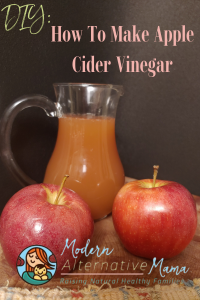By Rustina, Contributing Writer
Grocery shopping is so expensive, anymore! Shelling out all that hard-earned money is never fun. That is why I love being able to make as much as I can with each item that I buy. I love growing what I can, but I have a lot of work to do on my soil yet!
Maybe you already know, but apple cider vinegar is great to keep on hand! If you read, The Truth About Vinegar (and How to Use It), then you have learned about many of the benefits from vinegar, and especially apple cider vinegar. Now it is time to make some!
How to Make Your Own Apple Cider Vinegar
Ingredients:
- Apple scraps from 2-3 apples
- Skin peelings and cores are great for this project!
- If resizing this recipe: it is about ⅔ of the jar.
- 1 Tbsp of Sugar
- If resizing this recipe: it is 1 Tbsp per 1 cup of water.
- See notes below regarding questions about the necessity of sugar.
- 1 cup of Filtered Water or more if that does not cover the apple scraps
- Make sure your water filter removes chlorine, or let the water you intend to use sit out in a bowl overnight to naturally evaporate the chlorine. The chlorine can harm the bacteria we are hoping to help grow for fermentation.
Supplies:
- Spoon
- A quart jar
- A medium sized bowl or jar
- Piece of cotton that fits over the jar opening and a rubber band or string to hold the cloth down
Directions:
Step 1: Fill a clean, glass jar with the apple peels and cores.
Step 2: Stir the sugar into the water until it’s mostly dissolved.
Step 3: Pour the water/sugar mix over the apple scraps. Pour in enough to thoroughly cover the apple scraps while leaving at least 2 inches of empty space in the jar for fermentation growth.
Step 4: Cover the top of the jar with the cotton; secure with a string, lid ring, or rubber band.
Step 5: Set in a warm, dark place for around two weeks.
Step 6: Stir every few days. If any brown or gray slime develops on the top, that is a good sign that fermentation is occurring. This slimy stuff is the Mother of Vinegar starting to grow! It is the collection of growing probiotics and enzymes that we are aiming to make happen!
Step 7: Once two weeks have passed, strain the scraps from the liquid into another clean jar. You can use the mother of Vinegar to pump up your next batch of ACV or use it along with the ACV you are bottling. The strained apple scraps can go to the chickens to eat or a compost pile.
Step 8: Set the strained liquid filled jar back into the warm, dark place for another 2-4 weeks in a clean jar covered with cotton. After this time, it is ready to be used as desired.
Notes:
#1 What if my apple scraps are sticking out of the water?
- You may be able to add water, but make sure there is a 1-2 inch space below the rim of the jar.
- Weights can be used for keeping scraps down such as a smaller lid, pie weights, fermentation weights, etc – just make sure they are clean.
#2 To sugar or not to sugar, that is the question.
- Some choose to forgo sugar, but that will strongly depend on the yeast that is available in your air and the sugar content of your apples. The sugar may need to be added in order to achieve fermentation though. This is not a big worry since the sugar will be converted into an alcohol during fermentation so there is very, very little sugar content left in the finished product.
#3 What is that slimy stuff growing on it?
- There will be a white or grayish scum that will form on the top. This is what you want! It is the “mother” vinegar developing the healthy bacteria for the fermentation process.
- Mold, however, is not good and will ruin ACV. The difference is in the texture. The “mother” will be slimy – mold will be furry or fuzzy looking. Be sure that the apples stay submerged under the water and that the jar/any weights used are clean to prevent mold.
#4 Why are there bubbles? Should there be bubbles?
- Yes! Bubbles show that there are chemical reactions happening inside your mixture. These reactions are the visual signs of the fermenting process, and may be noticeable before the mother vinegar even shows.
#5 It smells strong; should it smell like that?
- Fermenting is a very aromatic adventure! This means that there will be a lot of smells coming from your jar.
- In the beginning, it should be a light apple scent – sweet.
- Once the bubbles and mother appear, it will be a stronger apple scent with a pungent smell – stronger, sharper, not so pleasant.
- After the first fermentation is complete, then the more “classic” ACV smell of cider and vinegar are present – stronger, more cider than apple scent. This will deepen more during the next two weeks.
#6 Gnats and flies can be very attracted to ACV so be sure your jar is well covered with a breathable cloth or a very fine mesh fermentation-specific lid.


